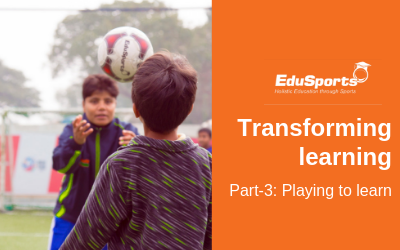“To succeed is to have failed” – learning from failures

Sports and experiential learning
A huge part of our childrens’ time is spent in being educated. This consists of classes at school as well as course work done at home. But is learning actually happening?
Survey after survey, every passing year, say that the learning levels in most of our schools aren’t at the level that they should be. Is there something that we are missing out on, something that we are not doing right? How do we solve this problem?
One solution could be ‘Experiential learning’
Have you ever heard of anyone learning to swim or playing the guitar by only reading a book? It would be simply impossible. If we accept that it is impossible for children to learn any sport or art form with only theory, then why don’t we extend this logic to academic subjects as well? This is where “Experiential learning” comes in.
I would like to define experiential learning as nothing other than “learning by doing”.
Experiential learning has been touted by educational experts around the world to be one of the best tools that is available for educators. Experiential Learning has shown to accelerate the learning process in children as well as adults. Whenever experiential learning is used to communicate or teach an idea, students tend to learn faster, understand ideas comprehensively and also tend to remember whatever they have learnt for longer.
Why does this happen?
The most obvious reason is the complete concentration and focus that is demanded from the individual while doing any activity. You simply cannot, not focus on the task at hand. And even if you do, you will soon fail at the activity. The feedback is immediate. You immediately know what you are doing wrong, and what you will need to do to get things right.
This is in stark contrast to a normal classroom session where children, can and do tend to lose attention to the class at hand. There is no immediate feedback or penalty for not paying attention. You will only realise the cost of this during examinations or tests, and by then it usually is too late.
Another benefit of experiential learning is that it tends to inculcate a behaviour of self-teaching, an extremely useful habit to have in a world where most of the human knowledge is available at our fingertips through the internet. There is no barrier for a person who has the motivation and intent to learn.
A clear example of the benefits of experiential learning can be seen in sports, especially when young athletes are coached to improve in their respective sports. Let us take an example of a football coach teaching how to head a football. He first describes how to do this verbally. He would mention that, to head the ball effectively one should always keep his or her eye on the ball; one must always connect the ball with your forehead and such. He then proceeds to demonstrate how this is done correctly. This is analogous to the introduction of an idea in a class in academic subjects. The athletes on observing the coach now try and replicate the activity. They know immediately if they are doing things in a right or a wrong manner. With constant and immediate feedback from the coach, they would know what they need to change in their technique to get things right. Complete focus is absolutely necessary to execute the technique accurately. And finally after the practice the coach has a discussion with the students on how they performed in the activity and where they went wrong and what they need to do to improve. Also, there is an emphasis on self-improvement and practicing to learn on one’s own. This initial necessity of practicing inculcates a habit of self-learning.
Although there are numerous benefits to experiential learning, on its own, it will not result in learning levels improving. Experiential learning should always be coupled with conventional or traditional teaching methods.
Experiential learning tends to work best when the idea is first communicated in an academic session, followed by the “Practical” session and then rounded off by a session reflecting on the activity conducted.
One significant challenge of experiential learning (as with any other teaching method) is that it is completely dependent upon intent of the child to learn. The emotional state of a child can either turbocharge or act as a hindrance for the learning process.
Emotional Priming for Education
We all know from our own experience that ’emotions’ is the essential criteria – on which we base most of our ‘rational’ decision making in our lives.
Development experts have long argued that we process all information through the filter of ’emotions’ before the ‘logical response’. In a series of telling experiments, scientists demonstrated that when you dissociate the ’emotion’ and ‘body’ from the process of cognition, rational behaviour and learning is absent.
This means that if our children do not have an ‘emotional commitment’ to ‘learning, they are unlikely to learn very much. This, in my view, is by far the single biggest problem our schools are facing today: how do you get the ’emotional commitment’ from the children required for any learning?
Sports as an enabler for education
What exactly do we mean by play? Let us address this first before moving on to how this helps us in education today.
Imagine a rock-climber inching his way up a huge, ominous looking rock completely absorbed in the intense effort to climb, or a runner drawing upon her every ounce of energy to finish the race, or a bunch of kids playing tag in a public park completely oblivious of the honking traffic or any other external noise. What is common in all these scenarios? All of them are deeply engaged in a game or sport they have chosen out of their own free will, an activity, ostensibly with no material gain, which is only worth doing for its own sake.
George Mallory, a fabled mountaineer who died while attempting to scale Mt. Everest almost two decades before Edmund Hillary and Tenzing Norgay officially accomplished the feat, was once asked: ‘Why do you want to climb Everest?’, he’s supposed to have replied ‘because it is there.’
Sport or play at its most fundamental level has a unique attribute. The players participate mostly for the sake of fun or enjoyment, without any notion of material gains or productivity. In fact, sometimes, it might seem like a sheer waste of time and energy.
So, what has this got to do with schools and learning? A lot!
Most schools prioritise academics over sports as the consensus is that performance in these fields determines career success. Hence, It should not come as a surprise why schools are also key agents of promoting inactivity, evident by the ever-reducing recess times and the number of sports periods in school timetables, for the simple reason that ‘playing’ for its own sake, does not seem very productive or outcome oriented.
Schools do promote sports and physical activity, but mainly in the form of organized or competitive sport, which offers but a small subset of ‘talented’ children an opportunity to win something material, a medal or a trophy, something to show for the investment that is put in terms of time and effort. Now, identifying and developing sporting talent from schools is an important and critical pursuit by itself, but this does not result in all children playing sports and does not contribute towards experiential learning.
And in most school sports programs, what tends to happen is that children are left on their own to play. This results in either them not engaging in any meaningful way, and consequently a lot of children get left out. What is required is an activity or a curriculum that is structured and ensures that every child is included and every child is meaningfully engaged.
How does sport engender a positive sentiment or feeling towards learning?
Imagine a bunch of kids playing a game of ‘seven stones’. The game requires them to take a series of rapid decisions at every point, right from how they should throw the ball, to which place should they dash to if the ball hits the stones, and the manner in which they should come together to fix the stones and so on.
At the end of the session, let’s assume a teacher walks up to these children and calls out the fact that she noticed them taking some highly intelligent decisions while they were playing and goes on to discuss the merits of some of these decisions to some detail.
The adult’s intervention helps reinforce the link between the act of play and their innate ability to reason, leaving a residue of positive emotion for the children.
The session also helps the children in developing an intuitive sense around their body’s ability to move in multiple ways. The act of playing sports includes the cerebral processes of reasoning and problem solving, getting actualized at once in the mind through movement and getting stored in our minds as ‘learning’ or ‘experience’. By playing of their own volition, children are activating parts of their brain that is responsible for cognition and motor competence.
Do you think that there is a higher chance that these children playing would have a stronger emotional commitment for a downstream math or science class? There’s huge amount of data & evidence around the globe and from our work with children in schools for the past decade that supports this assertion.
We have consistently seen increased attendance levels, improved class engagement in government schools where we have introduced our program. Academic performances have also significantly improved whenever children are consistently involved in physical activity.
Why does this happen? How does sport prime children emotionally to learn?
Play is a natural impulse in all children which fuels an anticipation of ‘pleasure’, a necessary condition for any learning to happen. During play children are able to operate in an ‘alternate reality’ or a ‘make-believe’ land. Any ‘feelings’ that are felt during play, although felt in an alternate reality, not only will become part of their psyche or consciousness but will soon pervade beyond the game into ‘real life’. Deep ties bind thought, emotion and movement – a fact illuminated whenever someone steps out to play. We can also change our children’s ‘reality’ by changing their attention and feelings towards it.
There is also scientific evidence of the benefits of sport beyond the basic health and fitness benefits and which extends into the basic structure of the brain.
“Intelligence in humans, measured in the form of IQ, depends more on the body than we realize. Learning and thought – including aspects of cognition and creativity – are not just the process of the head, but of the whole body.”
“Learning involves building of skills, and skills of every manner are built only through movement of muscles but also the intellectual skills used in classrooms and workplaces. It is evident that movement or physical activity – realizes or anchors the thought in the body – and this anchoring is stored in our mind as experience – or what we call as learning.”
(Hannaford, Smart Moves)
The fact is that play or movement enables learning via the entire sensory-motor system and if used judiciously and generously in our education process can accelerate the learning levels of children exponentially. As educators and parents, it is necessary that we let our learning environments be ‘invaded’ with generous sessions of play, movement and games – both structured and unstructured.
In conclusion, to improve current learning levels in schools there needs to be a combination of traditional teaching methods to introduce ideas; experiential learning sessions to cement these ideas in children’s’ minds through practical sessions; and finally, tools to ensure they are ‘emotionally’ ready to learn. And one of the best tools that we can use to ensure that children are emotionally primed to learn is sport.





